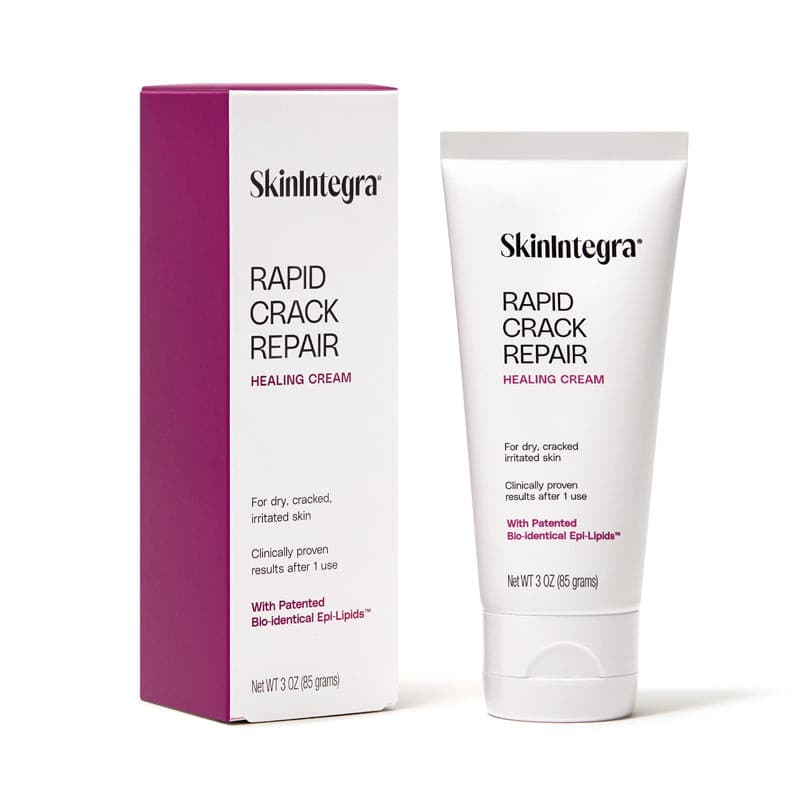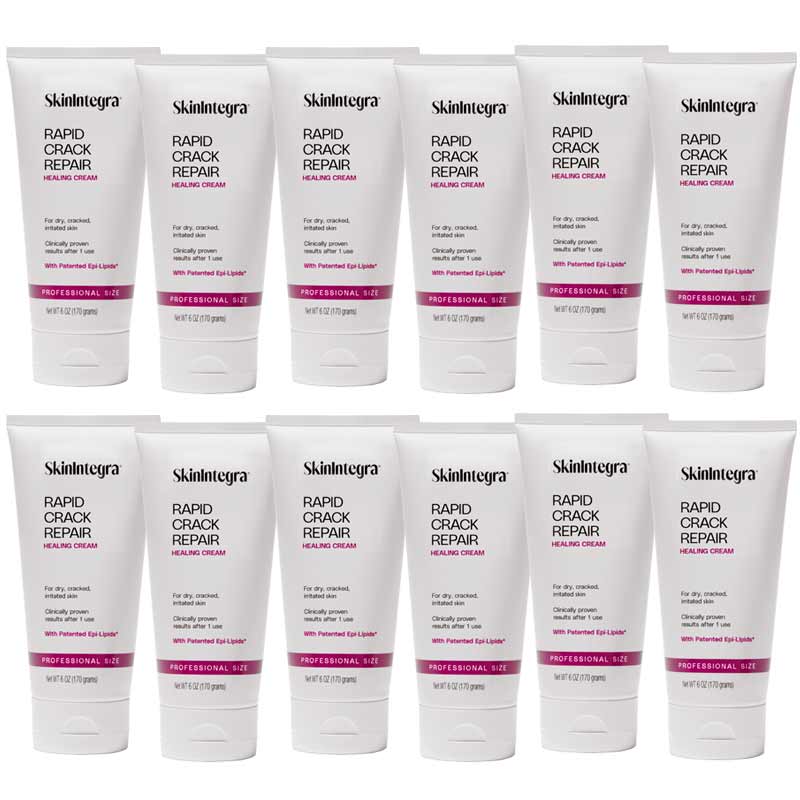Menopause can be an uncomfortable time in a woman’s life. The decline in hormone production affects many systems in the body, triggering symptoms like hot flashes, mood swings, sleep disruption—and, less talked about but equally frustrating, dry, cracked heels.
If you’re in your late 40s, 50s, or beyond and wondering why your feet suddenly feel drier or more prone to splitting, you’re not alone. In this guide, we’ll explore why cracked heels become more common during and after menopause, what causes them, and how to restore softness, hydration, and comfort to your feet.
How Hormones Affect Skin Aging
Hormonal changes during menopause impact far more than your reproductive system—they affect how your skin looks, feels, and heals. Estrogen plays a critical role in maintaining skin hydration by regulating the production of collagen, ceramides, and sebum (your skin’s natural oil). As estrogen declines, skin becomes thinner, less elastic, and more prone to dryness and irritation.
In addition to increased water loss through the skin, collagen breakdown leads to structural weakening—resulting in fine lines, slower wound healing, and a reduced ability to bounce back after stress. These effects are especially noticeable on the feet, where skin is already subject to pressure and friction. For postmenopausal women, this hormonal shift creates a “perfect storm” of dryness, nutrient loss, and slower repair, especially at the heels.
Why Menopause Affects Skin on the Feet
Estrogen plays a central role in keeping skin firm, hydrated, and elastic. It boosts collagen production and supports the natural lipid layer that retains moisture. As estrogen levels decline during menopause, this protective barrier weakens. Additionally, weight gain during menopause can add mechanical pressure to the heel, increasing the likelihood of skin breakdown.
The result? Skin becomes:
-
Less efficient at producing and retaining moisture
-
Lacking in the natural oils and nutrients that keep it soft and resilient
-
Drier and thinner
-
More prone to cracks and fissures
-
Slower to heal
Because the heels bear so much pressure and friction, they’re often the first place this dryness shows up. And if cracks are left untreated, they can deepen, bleed, or become infected—turning a simple annoyance into a painful issue.
Why cracked heels bleed and how to treat them.
What Are the Symptoms of Menopause-Related Heel Cracks?
You might notice:
-
Skin that feels dry or rough despite moisturizing
-
Small cracks that worsen over time
-
Thickened skin that peels or flakes
-
Discomfort when walking barefoot
-
In advanced cases: deep fissures, bleeding, or pain
These symptoms are often mistaken for just dry feet, but they reflect a deeper skin barrier dysfunction linked to hormonal changes. This isn't limited to feet — dermatologists note that menopausal dryness often affects the whole body, from arms and legs to nails and heels.
Other Foot Issues That Can Arise After Menopause
While cracked heels are a leading complaint, reduced estrogen and collagen can also affect:
-
Bunions: Soft tissue laxity can allow the big toe joint to shift
-
Hallux rigidus: Arthritis in the toe joint may worsen due to collagen loss
-
Plantar Fasciitis: Hormonal changes and weight gain can contribute to heel inflammation, compounding discomfort from dryness or cracking
Caring for your feet holistically during menopause is essential to maintaining mobility and comfort.
How to Treat Cracked Heels Safely at Home
Caring for postmenopausal feet doesn’t have to be complicated. A few targeted changes can dramatically improve skin resilience and comfort.
1. Soak & Gently Exfoliate
-
Use lukewarm water for 10-15 minutes (Note: If you have diabetes or circulation issues, consult your healthcare provider before soaking or using a pumice stone. Over-soaking or abrasion can increase the risk of skin breakdown or infection.)
-
Avoid hot water, which dries skin further
-
Gently buff thickened skin with a pumice stone (only if approved by your provider)
2. Moisturize Immediately
-
Apply a urea-based cream within 3 minutes of toweling dry
-
Look for barrier-repair ingredients like hyaluronic acid, ceramides, and natural oils
3. Protect Overnight
-
Wear cotton socks after moisturizing to lock in hydration
-
Sleep in a cooler room to avoid drying out your feet
4. Avoid Irritants
-
Skip products with fragrance, alcohol, or petroleum
-
Choose creams designed for sensitive or compromised skin
A Targeted Solution: SkinIntegra® Rapid Crack Repair Cream

SkinIntegra’s Rapid Crack Repair Cream was designed for skin that struggles to heal on its own—including postmenopausal skin affected by hormone-driven moisture loss and thinning.
What makes it different?
Many of the skin barrier issues caused by menopause—such as moisture loss, nutrient depletion, and slower healing—mirror those experienced by people with diabetes. SkinIntegra was originally formulated to restore dry, diabetic skin and is uniquely suited to support postmenopausal skin health as well.
Why skin barrier repair is essential in diabetic foot care.
-
25% Urea + Lactic Acid: Gently exfoliates thick, dry skin without irritation
-
Hyaluronic Acid, Ceramides, Plant Oils, and Omega 3s: Deeply moisturize and restore barrier lipids, nutrients, and hydration
-
Skin Barrier-Mimicking Composition: Its patented formula is engineered to resemble the lipid and hydration profile of a healthy skin barrier—helping restore skin nutritional efficiency and retain moisture longer
-
Free from irritants: No fragrance, dyes, parabens, petroleum, or phthalates
-
Clinically tested: Users report visible improvement within hours, not days
"I was surprised how fast the product produced results. I've also heard from patients that their heels are well-hydrated, and some even use it on dry cuticles!"
— Dr. Karen Luther, Board-Certified Podiatrist, Pennsylvania
SkinIntegra is also approved by the American Podiatric Medical Association (APMA)—a mark of safety and efficacy on diabetic and at-risk skin.
Apply a clinically-backed urea cream for cracked heels twice daily for best results.
Shop SkinIntegra Rapid Crack Repair Cream
Prevention Tips for Postmenopausal Cracked Heels
-
Moisturize Twice a Day with a barrier-repair cream formulated for sensitive or aging skin. Apply right after bathing to lock in moisture.
-
Include Omega-3 Rich Foods like salmon, walnuts, or flax to support your skin’s oil barrier from within.
-
Use Non-Irritating Cleansers without fragrance or drying alcohols. Consider pH-balanced cleansers that help preserve the skin’s natural acid mantle.
-
Avoid Hot Showers which can strip moisture and damage already sensitive skin. Use lukewarm water and limit baths to under 10 minutes.
-
Wear Cotton Socks to help retain moisture and reduce friction without overheating your feet. Avoid wool or synthetic blends that can irritate dry skin.
-
Exfoliate with Care. Gentle exfoliation with a soft brush or mild AHA-based lotion can help creams absorb better—just avoid aggressive scrubbing. (Note: If you have diabetes or circulation issues, consult your healthcare provider before using a pumice stone. Abrasion can increase the risk of skin breakdown or infection). How to safely exfoliate diabetic or sensitive feet.
-
Stay Hydrated from the inside out. Aim for 8–10 cups (2–2.5 liters) of water daily unless directed otherwise by your doctor.
-
Wear Supportive Shoes to reduce friction.
-
Avoid Walking Barefoot, especially on hard surfaces.
When to See a Doctor
It’s important not to ignore persistent or painful heel cracks—especially if you have underlying conditions that affect circulation or immune function.
Contact a dermatologist or podiatrist if:
-
Cracks are deep or bleeding
-
You see signs of infection (redness, pus, swelling)
-
Moisturizers don’t improve your skin within 7–10 days
-
You also have diabetes or circulation issues
-
You experience itching and cracking along with white patches or odor (possible signs of a fungal infection)
-
Over-the-counter creams have no effect after 2 weeks of consistent use
Frequently Asked Questions (FAQ)
Q: Why do my heels crack after menopause?
A: Declining estrogen reduces skin hydration and collagen production, making skin thinner, drier, and more prone to cracking.
Q: Is this just dry skin or something more serious?
A: It could be a more advanced skin barrier issue. Persistent or painful cracks deserve medical attention.
Q: Can I use a foot file or pumice stone?
A: Only gently and not if the skin is broken. Overuse can make cracks worse. (Note: If you have diabetes or circulation issues, consult your healthcare provider before using a foot file or a pumice stone. Abrasion can increase the risk of skin breakdown or infection).
Q: How fast does SkinIntegra work?
A: Many users report visible improvement in 24 hours. The formula is designed to relieve dryness fast and repair the barrier over time.
Take Control of Your Foot Health After Menopause
Cracked heels are a common, frustrating side effect of hormonal changes after menopause—but you don’t have to live with them. With the right care, your skin can regain its softness and resilience.
Choose clinically backed treatments like SkinIntegra Rapid Crack Repair Cream, and make daily foot care a priority. Your feet carry you through life—let’s keep them healthy, supple, and pain-free.





